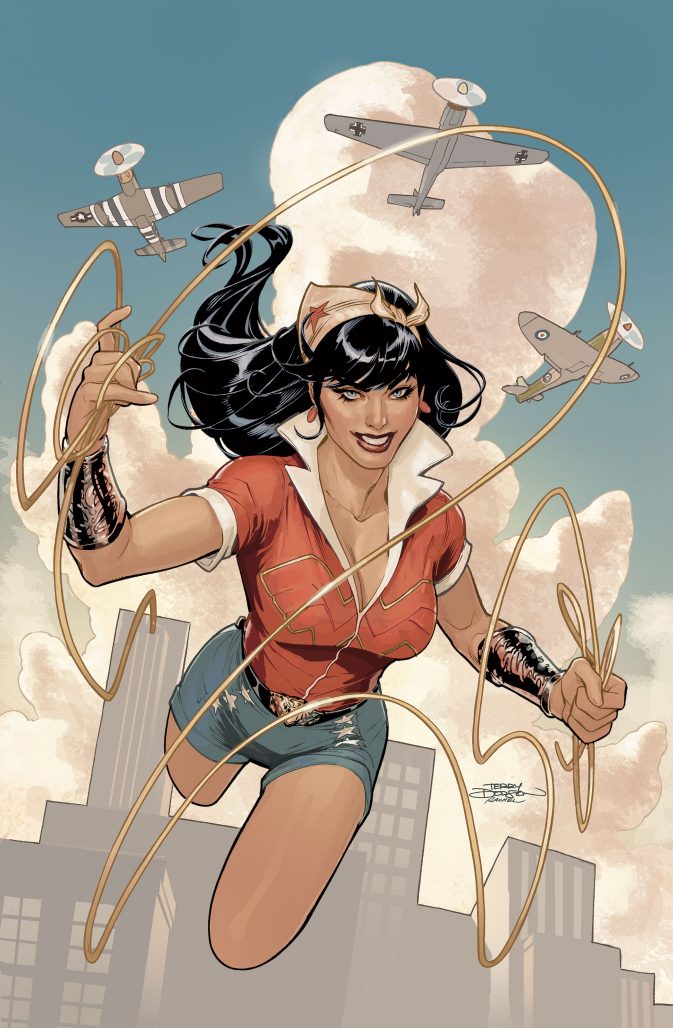
In the six years since the DC Comics Bombshells debuted as a line of prints, statues, and variant covers designed by Ant Lucia, this unique take on DC’s greatest superheroines has taken over the world. There are fashion lines, Funko pops, Vinyl vigures, playing cards, and even Bombshell costume sewing patterns. Foremost, however, there’s the Bombshells comic written by Marguerite Bennett and drawn by a group of artists such as Mirka Andolfo and Lauren Braga who, week after week, bring these characters’ inspiring stories to life. Later this month, Bombshells will finish its run with the release of Bombshells #100, but this isn’t the end for the series.
Beginning on August 25th, DC Comics will release Bombshells United as a weekly digital first title. Bennett will return to write the series and will be joined by a rotating team of artists– many of whom are veterans from the first Bombshells series. This new series will continue the adventures of the bombastic heroines fans have come to know and love with some poignant changes that will make the story more resonant for the challenging and historic times that we live in.
Bennett always intended Bombshells to be a series that combined her two great loves: superheroines and history. As a child, after reading all the fairy tales and listening to her father tell her about all the Twilight Zone episodes she could stomach, Bennett still had a craving for more stories. Her parents and step parents were all history teachers or professors at some point in their lives, so when Bennett asked for bigger and bolder narratives, they told her about Alexander the Great’s Battle at Thebes. They told her about the Siege of Leningrad. The Civil War. And most of all, World War II. Thus, when DC Comics approached Bennett about working on Bombshells, she couldn’t refuse. But she did have some firm ideas about where she would take the concept.
“I didn’t want it to be a story where [the premise was] ‘oh all the men are off and away, so I guess the women will have to do something,'” Bennett explained. “I just wanted to [start with the idea that] ‘the women were here first.’ No heroine is derivative of a male counterpart…it wasn’t like Superman existed and then Supergirl [did]– it was going to be her first.” For the last two years, this core conceit of “women first” has inspired a variety of deeply moving stories about DC’s greatest heroines including Wonder Woman, Batwoman, Mera, and Vixen. More than simple action and adventure stories, Bombshell‘s 100 issue run has been an inspiring treatise about the brutality of war, the power of sisterhood, and the idea that you are not defined by your past– you can always be better than you were.
It was important to Bennett to make her takes on DC’s greatest heroines less inherently perfect and to provide them with the opportunity for improvement and redemption. “I’m very into fallible heroines,” Bennett explained. “I understand why so many inspirational characters are given to girls, whether it’s to make up for the years that their weren’t any or that there were so many damsels in distress, but there’s a degree at which when we only give children– but little girls especially– aspirational heroines, we’re denying them the ability to screw up. To have a complete human experience. Being a child and seeing these role models, I knew that I could never possibly compete or live up, so when I screwed up it was horrible. These characters weren’t afforded the opportunity to fail and come back from it.”
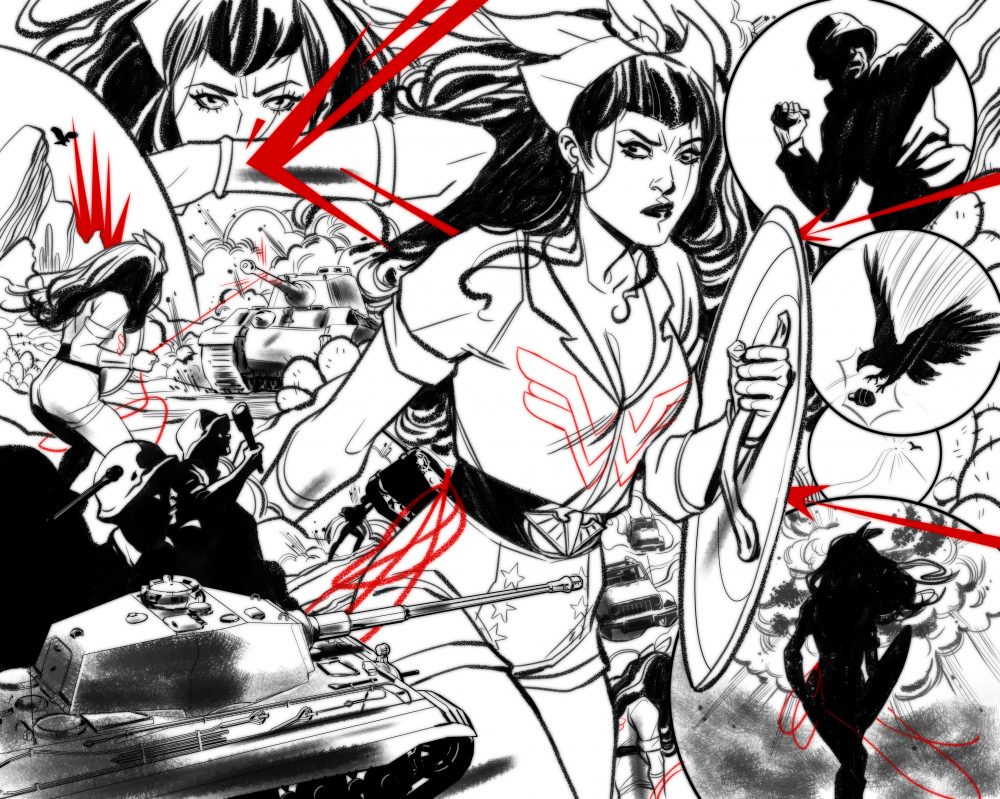
Indeed, the first arc of Bombshells United is all about failure– in particular, America’s failure to protect the rights of up to 120,000 Japanese Americans when the national government imprisoned them in internment camps for the duration of World War II. In Bennett’s exploration of Japanese American internment, she casts Cassie Sandsmark and Donna Troy, two characters who have carried the Wonder Girl moniker, as second generation Japanese Americans whose friends and family are being held against their will. While Cassie and Donna are not Japanese in the mainstream DC Universe, according to Bennett, these are her universe’s “definitive versions” of the characters.
Bennett was inspired to tell this story in Bombshells United after a trip back to her family home. She was flipping through a younger cousin’s history textbook and noticed that the chapter on World War II made no mention of Japanese American internment during the war. Perturbed, she asked to see another cousin’s high school level history textbook and found that that book made no mention of the tragedy, either. According to Bennett, the realization that this dark chapter of American history was being erased “inspired these feelings of horror and rage and…motivation, I suppose. If this was the kind of thing that was being ignored and scrubbed out of the story [of World War II]…if [the war] was being increasingly turned into good guys versus bad guys and one side is completely innocent and never did anything wrong…that needed to be addressed.”
Initially, Bennett expressed some reticence about whether she was the right person to tell this particular story. She said that she felt like she might be “overstepping.” However, she ultimately felt compelled to use her position as the writer of this deeply popular and historically-based series to “highlight something that should never ever be forgotten or removed from our national narrative.”
In order to make sure she told the story to the best of her ability, Bennett did research. A lot of research. She read “a variety of novels and history texts” and took several trips out to Manzanar, where she “took photos, walked around, and talked to some of the volunteers.” Finally, Bennett says she talked to a variety of Asian-American writers and editors in order to, in her words, “make sure what I was doing was respectful. It was just trying to learn as much as possible in order to convey this story that was honest, truthful, and drew heavily from the experiences of actual folk as opposed to doing something that was meant to either be sensational or so cut off from the actual human experiences that it would no longer resonate.”
Bennett highlighted the fact that she planned to include a reading list at the end of this first arc of Bombshells United. While in her story, Cassie, Donna, and their friends team up with Wonder Woman to challenge Japanese American internment, Bennett clarifies that obviously, “Wonder Woman did not appear to intervene in the real story of Japanese-American internment. It was the actual communities that affected real change. The reading list will basically say that these are the books you can read, these are the places you can visit, and these are the people you can speak to to learn how it actually went down.”
Additionally, Bennett wanted to make it clear that even in her story, the Japanese American community is the one making the plans to summon Wonder Woman and challenge their illegal detention. They’re in charge of their own destiny with Wonder Woman as an ally. As she put it, “I wanted to avoid a white savior thing at all costs, so I hope the power dynamics are very clear about who’s calling the shots in this story.”
In sum, Bennett said “Japanese Internment needed to be addressed and kept current, especially in discussions of immigration policy and…you know, just watching history repeat itself.” Indeed, in the time between Bombshells‘ launch and now, American political rhetoric has begun to echo elements of its regrettable past. After last year’s presidential election results, Bennett began to see the whole series differently, which colored her approach to Bombshells United.
When asked to define what separates Bombshells United from its progenitor, Bennett said, “In the first series, there was this sense of fun and excitement…with Bombshells United, we’re refocusing the series around a different conceit: the historical failures of the war and the question of ‘if you had had a second chance in life, what would you have done differently?’ I want to draw attention to the actual historical events and encourage readers to go and discover what actually happened.” Bennett said she hopes readers see the plights of the marginalized in Bombshells United and ask themselves “‘what could we have done?’ and ‘what do we need to remember so that when this situation arises again, we don’t make the same error?'”
Looking beyond the first arc, another major change to the direction of Bombshells United is the structure of the series as a whole. In the first Bombshells series, the title focused on a different set of heroes in each ten page chapter, which Bennett explained as “one of the difficulties of trying to tell the story of an entire universe of characters when you only have roughly the same number of pages as every other book out there that only focuses on one character.” She said that some readers felt “whiplash” thanks to this hectic storytelling structure, so in Bombshells United, each arc will focus on one heroine or team of heroines. “Then,” explained Bennett, “the next four or five issue arc will focus on a different group. That way, we’ll be able to visit everyone in turn– and yes, we’ll be seeing a lot of new heroines.”
Bennett teased the inclusion of Black Canary, Katana, and Bumblebee as new heroes in upcoming arcs. Conversely, she teased the return of old villains including Edward Nygma, Rhakontys the Bringer, and the Tenebrae. They’ll be joined by new villains such as Black Adam and Clayface as well as not-quite-villain Talia al Ghul. Generally speaking though, she hopes every character there is a Bombshells design for will get a moment in the sun, building towards a”truly bombastic finale” that will “will be build up and come together a few years down the line into something I hope is truly mindblowing.”
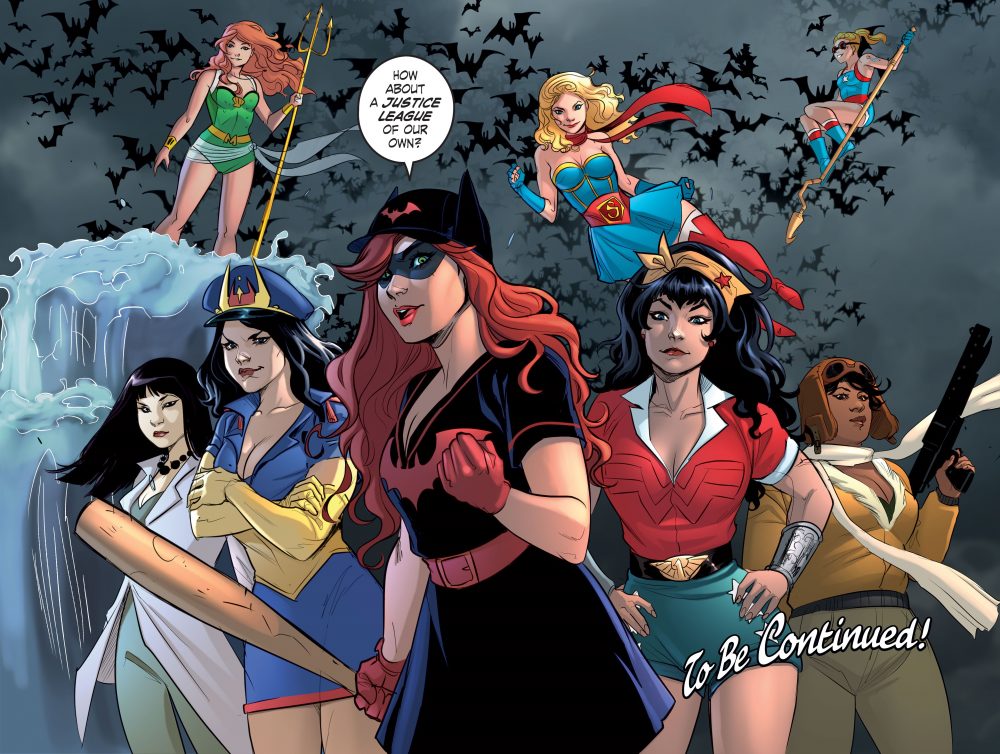
The first arc of Bombshells United will be drawn by fan favorite creator Marguerite Sauvage, whose work Bennett described as “so graceful, fluid, and gorgeous. She’s just magnificent and no one draws like her.” Bennett had high praise for all her other collaborators on Bombshells as well. She said that she’s “been so fortunate with the Bombshells team. Lauren Braga draws hair so luxuriously and Mirka Andolfo has the most amazing sense of comedic timing– whenever we have the chance to have her draw Harley Quinn, she is our champion. And Sandy Jarrell has this wonderful storybook quality– his Miriam Marvel stuff– when he was drawing her as Shazam, that was heartbreaking.” She hopes that all of her collaborators from Bombshells will return from Bombshells United.
Similarly to how each arc will focus on a particular heroine, each arc of Bombshells United will be attached to a particular artist rather than rotating from issue to issue. Bennett said she’s been “trying to refocus so that one artist is paired with a complete arc, so in some cases I’ve been writing stories that will not appear for another ten months so the artists have enough time to draw comfortably.”
Although everyone should check out the original Bombshells series, Bennett said readers would not have to do so in order to read Bombshells United. She said the creative team made sure that even if “you’ve never read a Bombshells issue before, you’ll be able to pick up Bombshells United #1 and understand who these people are, how they relate to each other, and what’s going on. We sort of have a Bombshells United ‘Rebirth’ issue that’s part of Batwoman’s arc that explains her history in this universe and her relationships with the other characters in this universe in a way that I hope is entertaining and emotional.”
Ultimately, Bennett hopes that Bombshells United is “fun.” However, she also hopes the book proves to be an “inspiring” opportunity to learn about the history of the world– both the good and the bad. She wants readers to understand that while they may not necessarily ever have to fight “an alien space god,” they will “have the chance to make a difference.”
Check out the Bombshells United solicitation info below:
BOMBSHELLS UNITEDWriter: Marguerite BennettArtist: Marguerite SauvageLetters: Wes AbbottCover for #1: Terry Dodson and Rachel DodsonCover for #2: Stephanie HansVariant cover: Babs TarrDigital Launch Date: August 25Chapters: weeklyPrint issues: collect 2 chapters and will double ship at $2.99Print issue #1: September 6Print issue #2: September 20“The Bombshells are back in an all-new series! As our new tale begins, the year is 1943, and Wonder Woman is called to Arizona for help by two young girls named Cassie Sandsmark and Donna Troy! The girls’ friends and families are being displaced from their homes and forced into internment camps! To save them, can Wonder Woman fight against the same people she once fought alongside?And in issue #2, Wonder Woman has set up refuge for Cassie Sandsmark and Donna Troy’s friends and families in the middle of the forest—but displacement is displacement, and they want to go home. Then, to make matters worse, a spy has infiltrated the camp! Has Wonder Woman put everyone in greater peril?”


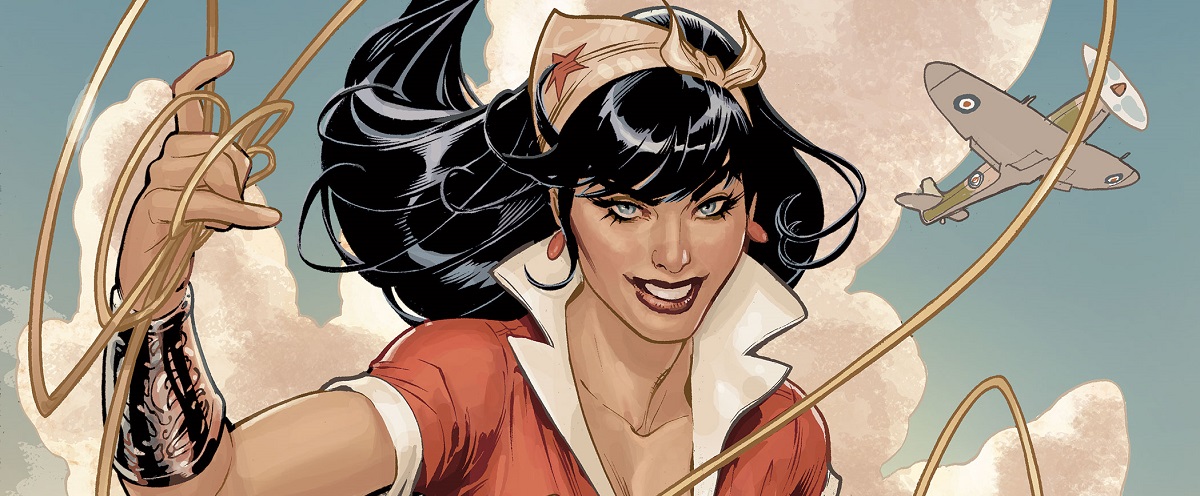



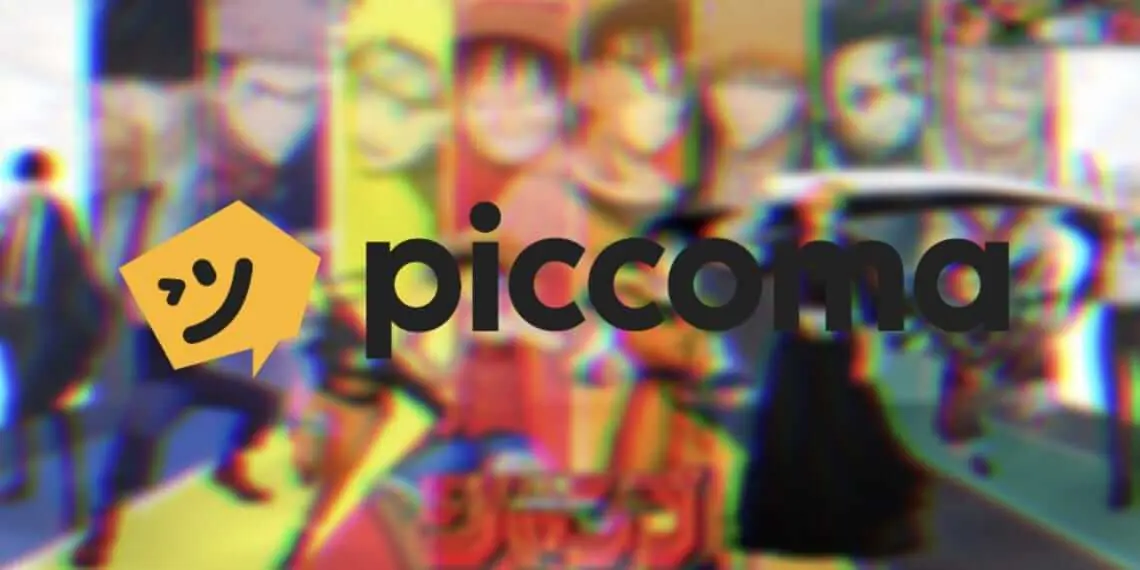

If Sauvage is in,then I am in, simple as that! Yay!
I don;t know who wrote this, but someone might want to change “refuse” to “refuge”:
“And in issue #2, Wonder Woman has set up refuse for Cassie Sandsmark and Donna Troy’s friends and families in the middle of the forest …”
Aside from that, what an excellent conceit. I need to check both series out when I get the chance.
I hope the context is explained and not conflated with enforcing current immigration policy, because history is not repeating itself. I know first hand how damage Japanese internment did, and how the pain of that wrongful act still affects people today.
http://salutemag.com/new-bombshells-series-coming-soon/
Comments are closed.